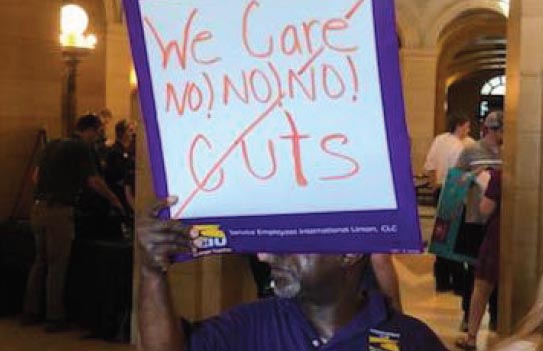2019: At long last, advocates see big wins on staff wages
Access Press
6/10/2019 by Access Press Staff
After years of effort and frustration, an increase in wages for direct support providers is one of the biggest gains at the capitol. The health and human services budget bill signed in May 2019 by Gov. Tim Walz includes workforce-related items that the disability community has clamored for.
Walz’s promise to make home and community-based services a priority came true with the passage of legislation including a competitive workforce factor for the Disability Waiver Rate System (DWRS). Getting the 4.7 percent competitive workforce factor was seen as a crucial move toward resolving the 17 percent gap in wages between care workers and other employment sectors.
The decision and signing of the health and human services legislation prompted an outpouring of thank you messages. ARRM posted a YouTube video of thanks to mark the session's end and the gains made. The Best Life Alliance, a coalition of more than 130 organizations, people with disabilities, families and their supporters, prepared and distributed thank you letterhead.

SEIU Healthcare Minnesota members turned out in force for a "Care Not Cuts" rally during the 2019 session.
The decision and signing of the health and human services legislation prompted an outpouring of thank you messages. ARRM posted a YouTube video of thanks to mark the session’s end and the gains made. The Best Life Alliance, a coalition of more than 130 organizations, people with disabilities, families and their supporters, prepared and distributed thank you letterhead.
Advocates this session hammered home the message that the severe workforce shortage has had profoundly negative impacts on more than 30,000 Minnesotans who rely on support services. More than 100,000 direct support staff work in Minnesota. At any given time, the state has several thousand support staff vacancies. Having a competitive workforce factor is seen as way to make wages attractive, and keep workers from going into other fields.
Another effort to address the workforce shortage is changes in Consumer-Directed Community Supports (CDCS), which are seen as providing more shared services options for clients, to potentially reduce the staff time needed. But the centerpiece this session was addressing worker wages.
When Walz released his budget, it included the competitive wage factor. That is expected to increase the part of Medicaid waiver reimbursement rates dedicated to support staff wages, and a more frequent rate adjustment based on Bureau of Labor Statistic data.
Any changes to DWRS require federal review. In January 2014, DHS established what we now call the DWRS, as a way to provide people with disabilities with the chance to live in their home communities, not institutions. The “waiver” part of DWRS is because some federal requirements for the use of Medicaid are waived. For a long time, counties ran the DWRS programs, so there were cost variations. That raised red flags for federal officials in 2007, more than a decade ago.
SEIU Healthcare Minnesota also celebrated its workers’ gains. More than 25,000 home care workers represented by SEIU Healthcare Minnesota are covered in a two-year contract that was part of the omnibus HHS bill.

